Local
D.C. police chief assailed at hate crimes hearing
Representatives of the LGBT community and the head of the D.C. police union told a City Council hearing on Nov. 20 that District Police Chief Cathy Lanier has failed to take adequate steps to curtail hate crimes targeting gays and transgender people.
Kris Baumann, chair of the Fraternal Order of Police, and officials with five local LGBT organizations said Lanier has turned down their repeated request to assign more officers to the department’s highly acclaimed Gay & Lesbian Liaison Unit, whose ranks have been reduced from seven to two members since Lanier became chief in 2007.
“What the chief has done is decimate that unit,” said gay activist Peter Rosenstein.
Lanier took strong exception to that assessment, telling the Council’s Committee on Public Safety and the Judiciary that she is expanding the GLLU and other special liaison units in the department by assigning officers “affiliated” with the units to each of the department’s seven police districts.
She said her plan calls for assigning a total of 57 officers or supervisors to all four of the special liason units, including the GLLU. She said about 20 of the 57 would be assigned to the GLLU, making it far more responsive to the community than a seven-member centralized unit.
Lanier told the committee she would keep her promise to LGBT activists to retain a small, centralized GLLU office.
But Baumann and Chris Farris, co-chair of Gays and Lesbians Opposing Violence, each said Lanier has “systematically” dismantled the GLLU’s operations under the promise of replacing it with a decentralized unit that she has yet to produce more than two years after she first proposed the reorganization.
“I am unfortunately significantly less optimistic today about this city’s willingness to tackle the difficult issue of hate crimes than I was a year ago,” Farris told the committee.
“I do not see what I think is needed – most importantly, leadership at the top, and a firm commitment to roll up our sleeves and treat the issue as it must be treated – holistically,” he said. “This means the MPD, the U.S. Attorney’s office, the D.C. Public School system, the mayor, and this City Council must all be unequivocally committed to the fight.”
Farris questioned recent police data showing the number of LGBT-related hate crime has decreased since 2006. He said he believes the decrease is due to a lack of reporting that came about as a result of GLLU’s reduction in staff and its inability to push more aggressively for reporting hate crimes.
Lanier and Assistant Chief Diane Grooms testified that a long-awaited training course for prospective GLLU officers would begin shortly. Lanier said she has found from her own conversations with LGBT officers that they prefer to remain in their regular units in the police districts rather than be “pigeonholed” in a special gay related unit.
She angered some of the activists attending the hearing when she said she didn’t believe they represent the views of LGBT people in the neighborhoods across the city.
Council member Phil Mendelson (D-At-Large), who chairs the committee, said he would continue to monitor the department’s response to hate crimes against all city residents. He and the LGBT representatives that testified at the hearing noted that anti-LGBT hate crimes in the city far outnumber hate crimes targeting other groups.
A report released last week by Mayor Adrian Fenty and Lanier, “Bias-Related Crime in the District of Columbia,” shows that “sexual orientation” related hate crimes comprised more than 70 percent of the total number of hate crimes in the city each year from 2005 through 2009.
So far this year, out of a total of 36 reported hate crimes, 30 were classified as “sexual orientation” related hate crimes.
Alison Gill, an official with the D.C. Trans Coalition, and Julius Agers, a transgender activist, told the committee they were pleased that Fenty and Lanier published the bias-related crime report – three years after the report was due under rules set by the City Council.
But the two said they were troubled that the report did not break down the statistics to show the number of hate crimes specifically targeting transgender people in the city. They noted that a number of widely reported anti-trans hate crimes have occurred in the District in recent years.
District of Columbia
Gay ANC member announces candidacy for Ward 1 D.C. Council seat
Community leader Brian Footer seeking seat held by Brianne Nadeau
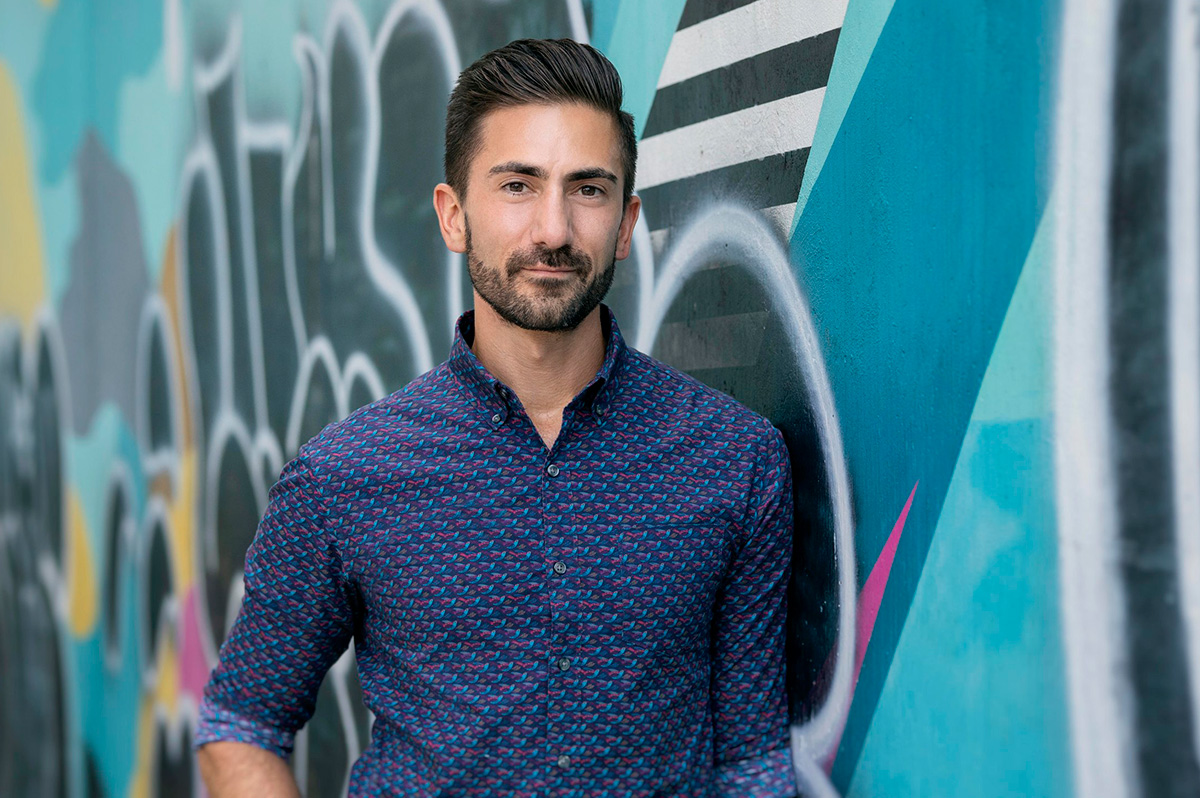
Gay Advisory Neighborhood Commissioner Brian Footer, a community activist who has been involved for many years in local and national government affairs, has announced his candidacy for the Ward 1 D.C. Council seat up for election in 2026.
Footer, a Democrat, will be running in the city’s June 2, 2026, Democratic primary for the Ward 1 Council seat, but it is uncertain whether he will be running against incumbent Ward 1 Council member Brianne Nadeau (D). Nadeau has not yet announced if she plans to run for re-election for a fourth term following her 12 years on the Council.
Nadeau has been a longtime vocal supporter of the LGBTQ community.
If Footer were to win the primary and the November 2026 general election, he would become the Council’s second openly gay member. Ward 5 Council member Zachary Parker (D) is currently the 13-member Council’s only gay member.
Footer is a three-term ANC commissioner who currently serves as Chair of ANC 1E, which represents the city’s Adams Morgan neighborhood.
“Brian has worked at every level of government — federal, state, and local — building a career rooted in public service, aging policy, and inclusive urban planning,” a statement on his campaign website says.
“I’m running for Council because too many people in Ward 1 are doing everything right and still feel ignored by the city they call home,” Footer states on his website.
“I’m running because we can do better,” his statement continues. “That means making housing more affordable, addressing homelessness with real solutions, and keeping our neighborhoods safe with smart, community focused strategies.”
When contacted by the Washington Blade for comment, Nadeau said she was not ready at this time to discuss her plans about running again or about Footer’s candidacy.
“The primary is a ways away, and I’m very focused right now on the budget and the stadium deal and all the work that we’re doing at the Council,” she told the Blade. “So, I really haven’t had time to turn to my plans. So, as a result, I’m also not going to be commenting on anybody else who is determined that they’re running at this time.”
She first won election to the Council in 2014 after she defeated four-term gay Ward 1 Council member Jim Graham in the Democratic primary after Graham became embroiled in an ethics controversy.
In the 2022 Democratic primary Nadeau defeated gay challenger Salah Czapary in a three-candidate race, by a margin of 48.5% of the vote compared to Czapary’s 30.9%.
With the third candidate, Sabel Harris, receiving 20.4%, the outcome showed that the two challengers had a combined total vote count higher than Nadeau.
Further details of Footer’s candidacy can be accessed from his campaign website, brianfooterdc.com.
District of Columbia
Gay GOP group hosts Ernst, 3 House members — all of whom oppose Equality Act
Log Cabin, congressional guest speakers mum on June 25 event
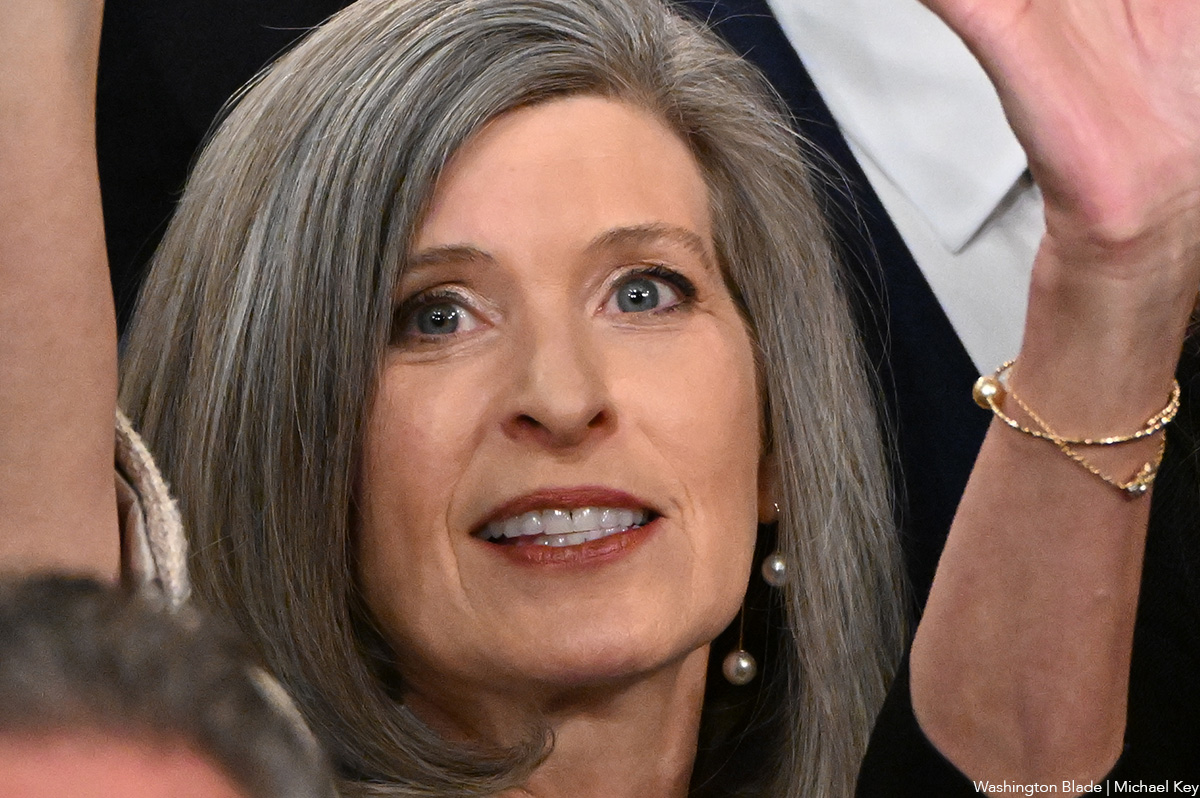
U.S. Sen. Joni Ernst (R-Iowa) and three women Republican members of the U.S. House appeared as guest speakers at the June 25 meeting of Log Cabin Republicans of D.C., the local chapter of the national LGBTQ Republican group with that same name.
The U.S. House members who joined Ernst as guest speakers at the Log Cabin meeting were Celeste Maloy (R-Utah), Kat Cammack (R-Fla.), and Julia Letlow (R-La.).
Neither D.C. Log Cabin Republicans President Andrew Minik nor spokespersons for Ernst or the three congresswomen immediately responded to a request by the Washington Blade for comment on the GOP lawmakers’ appearance at an LGBTQ GOP group’s meeting.
“Please join us for an inspiring evening as we celebrate and recognize the bold leadership and accomplishments of Republican women in Congress,” a D.C Log Cabin announcement sent to its members states.
“This month’s meeting will highlight the efforts of the Republican Women’s Caucus and explore key issues such as the Protection of Women and Girls In Sports Act and the broader fight to preserve women’s spaces in society,” the message says.
It was referring to legislation pending in Congress calling for banning transgender women from participating in women’s sports events.
According to media reports, Ernst and the three congresswomen have expressed opposition to the Equality Act, the longstanding bill pending in Congress calling for prohibiting discrimination based on sexual orientation and gender identity in the areas of employment, housing, and public accommodations.
The Log Cabin announcement says the meeting was scheduled to take place at the Royal Sands Social Club, which is a restaurant and bar at 26 N St., S.E. in the city’s Navy Yard area.
D.C. Log Cabin member Stuart West, who attended the meeting, confirmed that Ernst and the three congresswomen showed up and spoke at the event.
“It was a good turnout,” he said. “I would definitely say probably 30 or 40 people attended.” West added, “Four women came to talk to a group of mostly gay men. That’s something you don’t see very often.”
District of Columbia
D.C. police seek public’s help in July 5 murder of trans woman
Relative disputes initial decision not to list case as hate crime
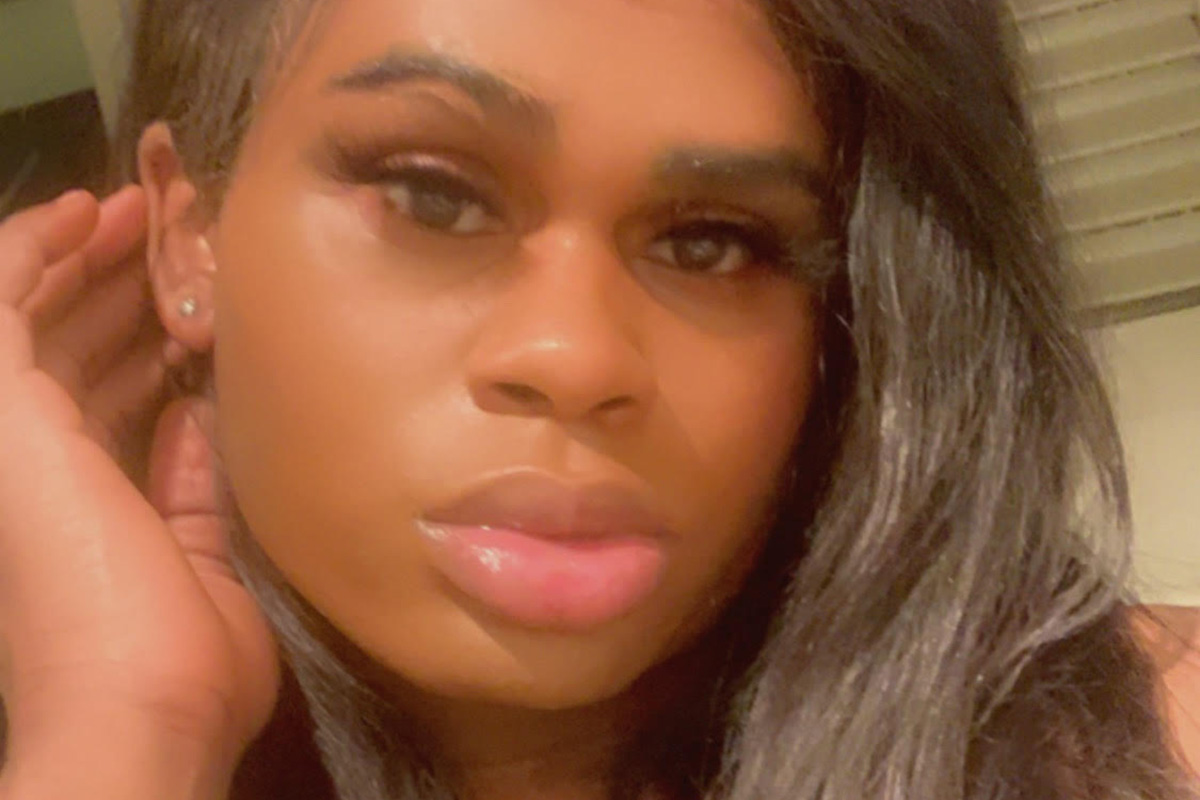
D.C. police are seeking help from the public in their investigation into the murder of a transgender woman who they say was shot to death at about 12:30 a.m. on Saturday, July 5, on the 2000 block of Benning Road, N.E.
But the police announcement of the fatal shooting and a police report obtained by the Washington Blade do not identify the victim, 28-year-old Daquane ‘Dream’ Johnson of Northeast D.C., as transgender. And the police report says the shooting is not currently listed as a suspected hate crime.
It was local transgender activists and one of Johnson’s family members, her aunt, who confirmed she was transgender and said information they obtained indicates the killing could have been a hate crime.
“On Saturday, July 5, at approximately 12:51 a.m., Sixth District officers were flagged down in the 2000 block of Benning Road, Northeast, for an unconscious female,” a July 5 D.C. police statement says. “Upon arrival, officers located an adult female victim suffering from gunshot wounds,” it says.
“D.C. Fire and EMS responded to the scene and transported the victim to a local hospital where after all lifesaving efforts failed and the victim was pronounced dead,” the statement says.
A separate police flyer with a photo of Johnson announces an award of $25,000 was being offered for information leading to the arrest and conviction of the person or persons responsible for the murder.
The flyer identifies D.C. police Homicide Detective Natasha Kennedy as being the lead investigator in the case and says anyone with information about the case should contact her at 202-380-6198.
Longtime D.C. transgender rights advocate Earline Budd told the Blade that one of the police investigators contacted her about the case and that she also spoke to Detective Kennedy. Budd said police confirmed to her that Johnson was a transgender woman.
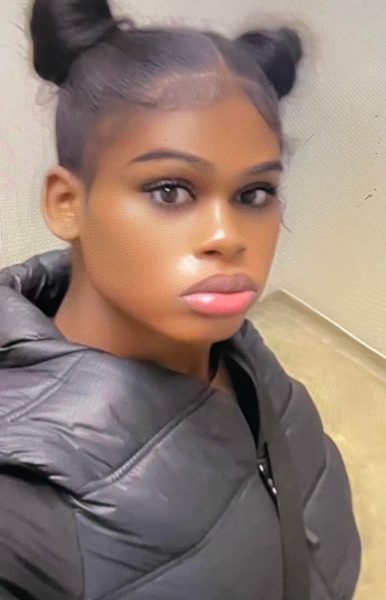
One of Johnson’s family members, Vanna Terrell, who identified herself as Johnson’s aunt, told the Blade that Johnson used the first name of Dream and had planned to legally adopt that name instead of Daquane but had not gotten around to doing so.
Terrell said she and other family members learned more about the incident when one of two teenage high school students who knew Johnson’s brother contacted a friend and told the friend that they recognized Johnson as they witnessed the shooting. Terrell said the friend then called her to tell her what the friend learned from the two witnesses.
According to Terrell, the witnesses reportedly saw three men approach Johnson as Johnson walked along Benning Road and one of them called Johnson a derogatory name, leading Terrell to believe the men recognized Johnson as a transgender woman.
Terrell said one of the witnesses told the friend, who spoke to Terrell, that the man who shot Johnson kept shooting her until all of the bullets were fired. Budd, who said she spoke to Terrell, who also told her what the witnesses reported, said she believed the multiple shots fired by the shooter was an “overkill” that appears to have been a hate crime. Terrell said she too believes the murder was a hate crime.
In response to an inquiry from the Blade, Officer Ebony Major, a D.C. police spokesperson, stated in an email, “At this point there is nothing in the investigation that indicates the offense was motivated by hate or bias.”
Terrell said a memorial gathering to honor Johnson’s life was scheduled to be held Saturday, July 12, at River Terrace Park, which is located at 500 36th St., N.E. not far from where the shooting occurred.
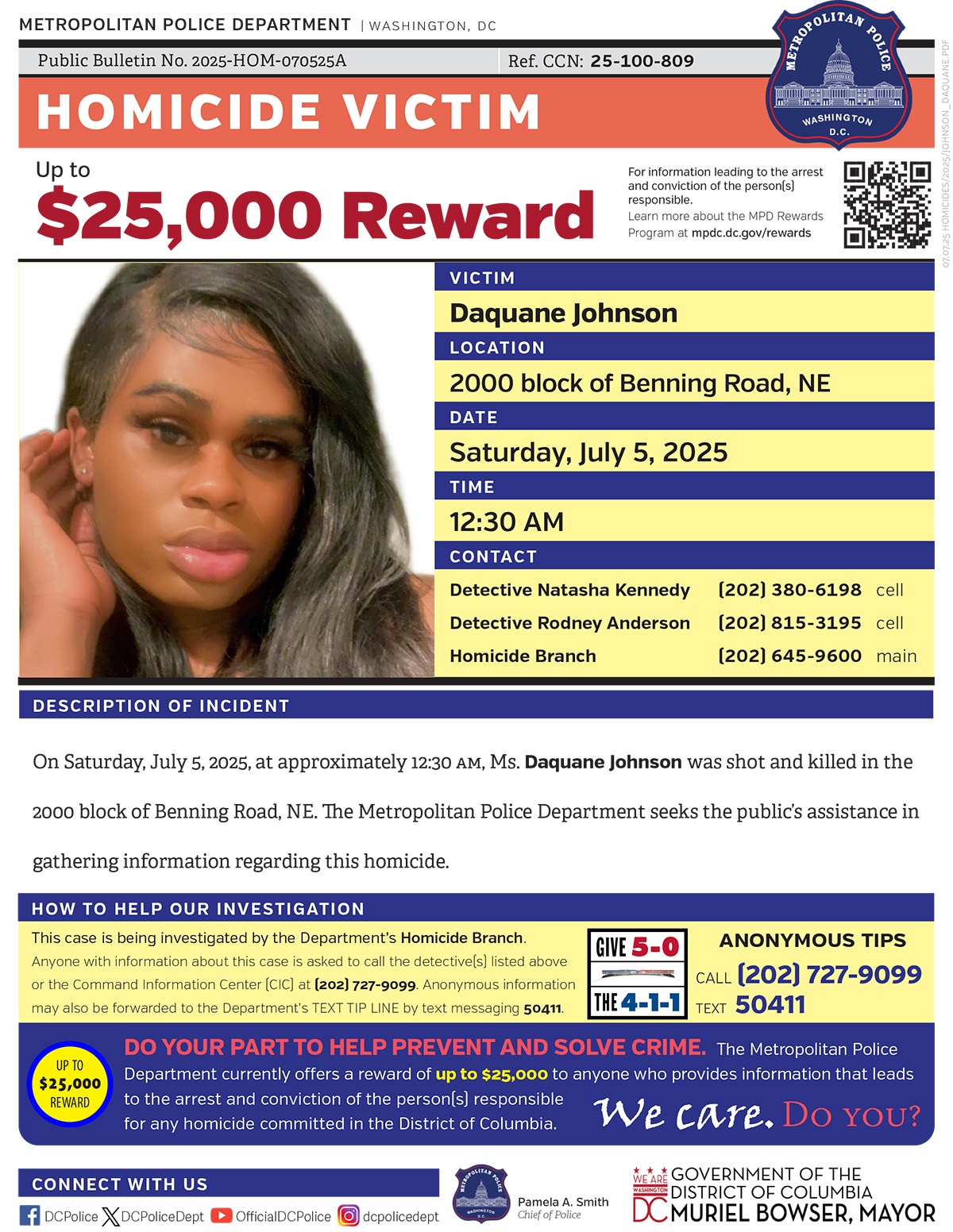
-

 Federal Government2 days ago
Federal Government2 days agoTreasury Department has a gay secretary but LGBTQ staff are under siege
-

 Virginia3 days ago
Virginia3 days agoDefying trends, new LGBTQ center opens in rural Winchester, Va.
-

 District of Columbia1 day ago
District of Columbia1 day agoGay GOP group hosts Ernst, 3 House members — all of whom oppose Equality Act
-

 Opinions4 days ago
Opinions4 days agoUSAID’s demise: America’s global betrayal of trust with LGBTQ people












